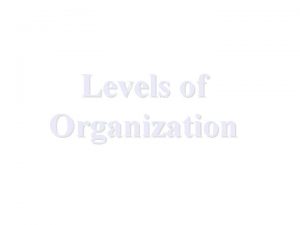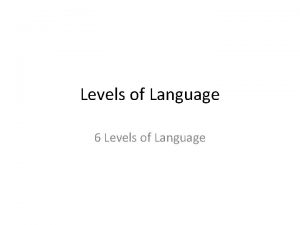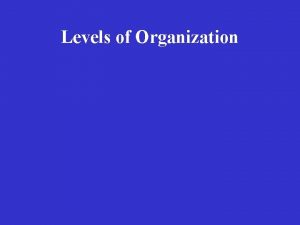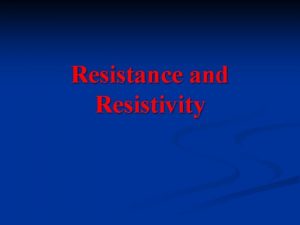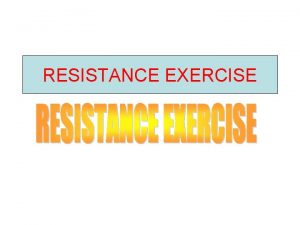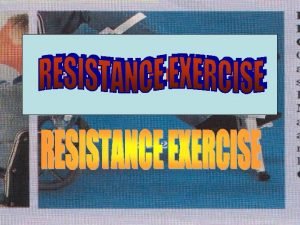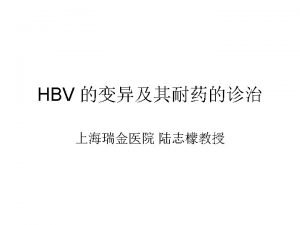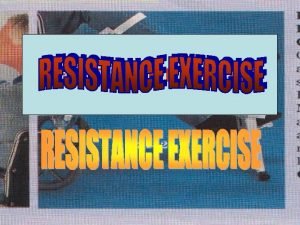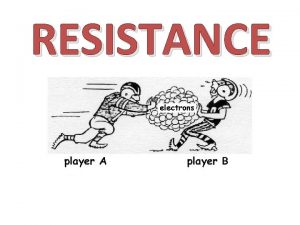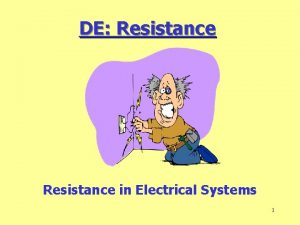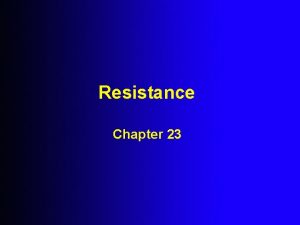The Support and Resistance Levels Support and Resistance
















- Slides: 16

The Support and Resistance Levels

Support and Resistance • Support and resistance represent key junctures where the forces of supply and demand meet. • When supply and demand are equal, prices move sideways • In the financial markets, prices are driven by excessive supply (down) and demand (up). As demand increases, prices advance and as supply increases, prices decline. • Supply is synonymous with bearish, bears and selling. Demand is synonymous with bullish, bulls and buying. These terms are used interchangeably throughout these presentations.

The Support Level • Support is the price level at which demand is assessed to be strong enough to prevent the price from declining further. • As the price declines towards support and gets cheaper, buyers become more inclined to buy and sellers become less inclined to sell. • By the time the price reaches the support level, it is believed that demand will overcome supply and prevent the price from falling below support. • Support does not always hold and a break below support signals that the bears have won out over the bulls. A decline below support indicates a new willingness to sell and/or a lack of incentive to buy. • Support breaks signal that sellers have reduced their expectations and are willing sell at even lower prices. In addition, buyers could not be encouraged to buy until prices declined below support or below the previous low. • Once support is broken, another support level will have to be established at a lower level.

The Support Level (60)

The Resistance Level • Resistance is the price level at which selling is assessed to be strong enough to prevent the price from rising further. • As the price advances towards resistance, sellers become more inclined to sell and buyers become less inclined to buy. • By the time the price reaches the resistance level, it is believed that supply will overcome demand prevent the price from rising above resistance. • Resistance does not always hold and a break above resistance signals that the bulls have won out over the bears. A break above resistance shows a new willingness to buy and/or a lack of incentive to sell. • New highs indicate buyers have increased their expectations and are willing to buy at even higher prices. In addition, sellers could not be encouraged to sell until prices rose above resistance or above the previous high. • Once resistance is broken, another resistance level will have to be established at a higher level.

The Resistance Level (75)

Highs and Lows • • Support can be established with the previous reaction lows. Resistance can be established by using the previous reaction highs. The above chart for HAL shows a trading range between Dec-99 and Mar-00. • Support was established with the October low around 31. • In December, the stock returned to support and formed a low around 33. • In February the stock again returned to the support zone and formed a low around 32, 5. After each bounce off support, the stock traded at all prices up to the resistance level. • Resistance was first established by the September support at 42. 5. After a support level is broken, it turns into a resistance level. • From the October lows, the stock advanced to the new resistance level around 42. 5. • When the stock failed to advance past 42. 5, the resistance level was confirmed. • The stock subsequently traded up to 42. 5 two more times after that and failed to surpass resistance both times.

Support and Resistance • Support levels are usually below the current price, but it is not uncommon for a security to trade at or near support. Sometimes it is difficult to set exact support levels. Price movements are volatile and can fall below support for a moment. It doesn't necessarily mean that support level has broken. • One can assume, support is broken if the price closes 10% below the established support level. For this reason, some traders establish support zones • Resistance levels are usually above the current price, but it is not uncommon for a security to trade at or near resistance. Price movements can be volatile and rise above resistance briefly. • Resistance level is considered to be broken, if the price closes 10% above the established level. It is common, that traders and investors establish resistance zones.

Support Equals Resistance • Another principle of technical analysis claims that support can turn into resistance and vice versa. • Once the price breaks below a support level, the broken support level can turn into resistance. – The break of support signals that the forces of supply have overcome the forces of demand. Therefore, if the price returns to this level, there is likely to be an increase in supply, and hence resistance. • Resistance turning into support. As the price advances above resistance, it signals changes in supply and demand. – The breakout above resistance proves that the forces of demand have overwhelmed the forces of supply. If the price returns to this level, there is likely to be an increase in demand support will be confirmed.

Support Equals Resistance • In this example of the NASDAQ 100 Index ($NDX), the stock broke resistance at 935 in May-97 and traded just above this resistance level for over a month. • The ability to remain above resistance established 935 is recognized as a new support level. • The stock subsequently rose to 1150, but then fell back to test support at 935. • After the second test of support at 935, this level is well established.

Support Equals Resistance Support can turn into resistance and then back into support. • Stock found support at 17, 5 (green oval), but broke below support in Mar-99 as the bears overpowered the bulls. • When the stock rebounded off 17, 5 level (red oval) , there was still overhead supply at 17, 5 and resistance was met from Jun-99 to Oct-99. Where does this overhead supply come from? Demand was obviously increasing around 18 from Oct-98 to Mar-99 (green oval). Therefore, there were a lot of bullish buyers of the stock around 18. When the price declined below 18 and fell to around 14, many of these (now unhappy) bulls were probably still holding the stock. This left a supply overhang around 18. When the stock rebounded to 18, many of the green-oval-bulls probably took the opportunity to sell and “escape” with little loss. When this supply was exhausted, the demand was able to overpower supply and advance above resistance at 17, 5.

Trading Range • • Trading ranges can play an important role in determining support and resistance as turning points or as continuation patterns. A trading range is a period of time when prices move within a relatively tight range. This signals that the forces of supply and demand are evenly balanced. When the price breaks out of the trading range, above or below, it signals that a winner has emerged. A break above is a victory for the bulls (demand) and a break below is a victory for the bears (supply). After an extended advance from 27 to 64, (WCOM) entered into a trading range between 55 and 63 for about 5 months. There was a false breakout in mid-June when the stock was briefly above 62 (red oval). This did not last long and the decline a few days later nullified the breakout The stock then proceeded to break support at 54, 5 in Aug-99 (black arrow) and trade as low as 50. Here is another example of support turned resistance as the stock bounced off 55 two more times before dropping lower.

In Nov/Dec-99, LU formed a trading range that resembled a head and shoulders pattern (red oval). When the stock broke support at 60, there was little or no time to exit. In hindsight, the support line could have been drawn as an upward sloping neckline (blue line), and the support break would have come at 61. This is only 1 point higher and a trader would have had to take action immediately to avoid a sharp fall. However, the lows match up rather nicely on the neckline, and it is something to consider when drawing support lines. After Lucent declined, a trading range was established between 40. 5 and 47. 5 for almost two months (green oval). The resistance level of the trading range was well marked by three reaction peaks at 47. 5. The support level was not as clearly marked, but appeared to be between 40 and 41. Some buying interest began to become evident around 44 in mid- to late-February. The stock then proceeded to raise and finally closed above resistance at 48. This was a clear indication of demand winning out over supply. There were still two more opportunities (days) to get in on the action. On the third day after the breakout, the stock gapped up and moved above 56.

Support and Resistance Zones • It is sometimes the case to create support and resistance zones. Sometimes, exact support and resistance levels are best, and, sometimes, zones work better. Each security has its own characteristics, and analysis should reflect the intricacies of the security. • Generally, the tighter the range, the more exact the level. If the trading range spans less than 2 months and the price range is relatively tight, then more exact support and resistance levels are best suited. • If a trading range spans many months and the price range is relatively large, then it is best to use support and resistance zones. These are only meant as general guidelines, and each trading range should be judged on its own merits.

Support and Resistance Zones • Returning to the analysis of Halliburton (HAL), we can see that the November high of the trading range (32 to 44) extended more than 20% past the October low, making the range quite large relative to the price. Because the September support break forms our first resistance level, we are ready to set up a resistance zone after the November high is formed, probably around early December. At this point though, we are still unsure if a large trading range will develop. The subsequent low in December, which was just higher than the October low, offers evidence that a trading range is forming, and we are ready to set the support zone. As long as the stock trades within the boundaries set by the support and resistance zone, we will consider the trading range to be valid. • Support may be looked upon as an opportunity to buy, and resistance as an opportunity to sell.

Conclusion • Identification of key support and resistance levels is an essential ingredient to successful technical analysis. Even though it is sometimes difficult to establish exact support and resistance levels, being aware of their existence and location can greatly enhance analysis and forecasting abilities. • If a security is approaching an important support level, it can serve as an alert to be extra vigilant in looking for signs of increased buying pressure and a potential reversal. • If a security is approaching a resistance level, it can act as an alert to look for signs of increased selling pressure and potential reversal. • If a support or resistance level is broken, it signals that the relationship between supply and demand has changed. A resistance breakout signals that demand (bulls) has gained the upper hand a support break signals that supply (bears) has won the battle.
 The inlet pressure in a constant rate filtration
The inlet pressure in a constant rate filtration Ignoring friction air resistance and electrical resistance
Ignoring friction air resistance and electrical resistance Costas levels
Costas levels Hát kết hợp bộ gõ cơ thể
Hát kết hợp bộ gõ cơ thể Lp html
Lp html Bổ thể
Bổ thể Tỉ lệ cơ thể trẻ em
Tỉ lệ cơ thể trẻ em Voi kéo gỗ như thế nào
Voi kéo gỗ như thế nào Tư thế worms-breton
Tư thế worms-breton Bài hát chúa yêu trần thế alleluia
Bài hát chúa yêu trần thế alleluia Các môn thể thao bắt đầu bằng từ đua
Các môn thể thao bắt đầu bằng từ đua Thế nào là hệ số cao nhất
Thế nào là hệ số cao nhất Các châu lục và đại dương trên thế giới
Các châu lục và đại dương trên thế giới Công thức tính thế năng
Công thức tính thế năng Trời xanh đây là của chúng ta thể thơ
Trời xanh đây là của chúng ta thể thơ Mật thư tọa độ 5x5
Mật thư tọa độ 5x5 101012 bằng
101012 bằng



















